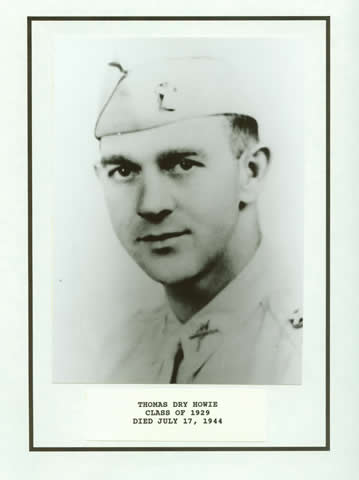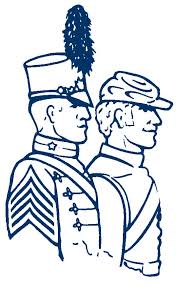29th Mourns “Major of St. Lo”
By Hal Boyle
With the 116th Infantry Regiment in France, July 23 – (delayed) – (AP)
They passed out Presidential citations today to officers and doughboys who cracked St. Lo, the eastern hinge of the German battle-line, and it was a sad ceremony to many because the “Major of St. Lo” was not alive to receive his.
The “Major of St. Lo” was Thomas D. Howie of Stauton, Va., one of the best beloved battalion leaders in the American army. He was killed July 17, the day before the city fell, after he broke through the Nazi wall to relieve another battalion of this regiment which was encircled on the outskirts.
Today the major lies in honor with other officers and men in the 29th division’s cemetery [1] – but on the day St. Lo was taken the dead major was carried through the streets in state in an ambulance and his flag-draped body was placed on a pile of rubble beside the shell-wrecked church of Ste Croix. The storming force passed in review through an artillery barrage thrown by the withdrawing Germans.
Howie was bald and in his middle thirties. He formerly taught English literature and coached boxing and football at Staunton Military academy. He was an athletic star himself earlier at The Citadel Military College, Charleston, S.C.
The wiry, muscular officer, a native of Abbeville, S.C., was popular with all ranks in the division from the lowest private to the commanding officer, Maj. Gen. Charles H. Gerhardt, who personally ordered Howie’s body taken into St. Lo by the combat force as a gesture honoring him and his battalion. By taking the high ground dominating the approaches to the city, his men sealed its fall.
“He had given up an operations post at regimental headquarters to take over the battalion only five days before,” said Capt. Charles B. Cawthon of Murfreesboro, Tenn., executive officer of the cut-off battalion to whose relief Howie and his troops came after they had been almost three days with no fresh rations or ammunition supplies.
“We have many officers in the army, but you can’t say of all that they are gentlemen. Major Howie was the finest gentleman I ever knew.”
“He certainly was,” added Lt. George E. Bryan of Allendale, S.C.
“I would like to have you talk to some of his stonewall buddies so you really can understand the fine type of man he was,” Cawthon said. “But there are not so many left. You know we came ashore on the toughest beach and it wasn’t any barbecue breaking through the Germans in front of St. Lo. His closest friend, Capt. Sherman V. Burroughs of Roanoke, Va., was killed before he got to the beach invasion day. I declare we have lost a lot of Virginia men.”
Just then Lt. Col. Sidney V. Binghem, Jr., Dallas, Texas, Cawthon’s battalion commander, who himself had served as executive officer for Howie when the latter led a battalion last year before taking up the regimental operations post, returned from the cemetery.
“There never was another man quite like Howie,” he said.
– Source: Associated Press / The State, Columbia, S.C., July 30, 1944, p.6.
[1] Thomas Dry Howie, Class of 1929, now rests in peace at Plot G Row 14 Grave 12, Normandy American Cemetery, Colleville-sur-Mer, France. Five more Citadel Men are interred at the cemetery and another is remembered on the Wall of the Missing./RL



Comments (0)